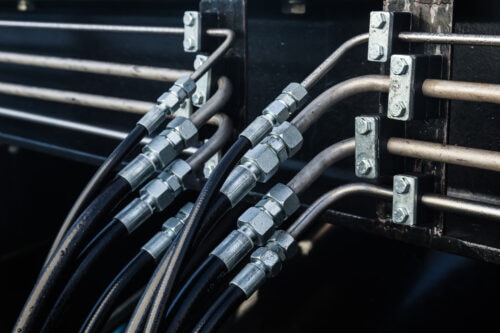When it comes to hydraulic fittings, there are a few things you need to keep in mind to ensure a proper fit. Buell Automatics Inc is here to create your custom hydraulic fittings for you. Hydraulic fittings are what we do best.
For precision machining services to guarantee that your hydraulic fittings meet your exact specifications, we can help you find the perfect hydraulic fitting. We will design a product that meets your specific needs using your specifications.
What is a hydraulic hose?
A hydraulic hose is a synthetic rubber tube that carries fluid to transmit force within hydraulic machinery. It has at least three parts: a fluid-carrying inner tube, reinforcement material, and protective outer skin. The inner tube’s fluid must be compatible with the inner tube’s flexibility.
A reinforcement layer is composed of a braided wire, a spirally coiled wire, or a textile yarn. Its outer layer will vary depending on whether the hose is meant for exposure to weather, oil, or abrasion.
Different types of hydraulic hoses
There are many different hydraulic hoses, each designed for a specific purpose. Some of the most common types include:
- A suction hose carries fluid from the reservoir to the pump in a hydraulic system.
- A return hose carries fluid from the hydraulic pump back to the reservoir.
- A pressure hose carries fluid from the hydraulic pump to the hydraulic cylinders or actuators in a hydraulic system.
- A drain hose removes hydraulic fluid leaking from the system.
What is a hydraulic fitting?
A hydraulic fitting is a coupling used to connect two hydraulic hoses or tubes. Some of the most common hydraulic fitting types include:
- An adapter connects two hydraulic hoses or tubes with different sizes or threads.
- An elbow connects two hydraulic hoses or tubes at an angle, typically 90 degrees.
- A tee connects three hydraulic hoses or tubes, typically in a T-shaped configuration.
- A coupling connects two hydraulic hoses or tubes.
- A flange connects two hydraulic hoses or tubes attached to a flanged fitting.
- A plug seals the end of a hydraulic hose or tube.
Benefits of using hydraulic fittings
Hydraulic fittings offer many benefits, including:
- It can help increase the efficiency of hydraulic systems by reducing friction and allowing for smoother operation.
- Reduces the need for maintenance by providing a tight seal that prevents leaks.
- Hydraulic fittings can enhance safety by preventing hydraulic fluid from escaping in the event of a leak.
- It improves the durability of hydraulic hoses and tubes by providing a secure connection that resists vibration and wears.
How are hydraulic fittings used?
A wide range of industries, from building and farming to oil and gas, rely on hydraulics, and hydraulic fittings play an essential part in these processes. Various types of hydraulic hoses, tubes, and valves can be joined with this fitting. In the event that your hydraulic hoses or tubes get broken, you may utilize hydraulic fittings to fix or replace them.
With Davenport screw machines, we manufacture parts for various industries, including hydraulics. The Davenport screw machining process offers many advantages to manufacturers, such as multi-spindle screw machines are often purchased based on factors such as turnaround time, speed, and cost efficiency. Clients can reduce costs by manufacturing at high volumes and eliminating secondary operations.
Trust us for all your hydraulics needs
We would love to hear from you if you are in the market for hydraulic fittings machining. Our team of experts here at Buell Automatics Inc can help you get the best fittings for your needs and ensure they are machined perfectly to spec. Contact us today and let us show you what we can do!





